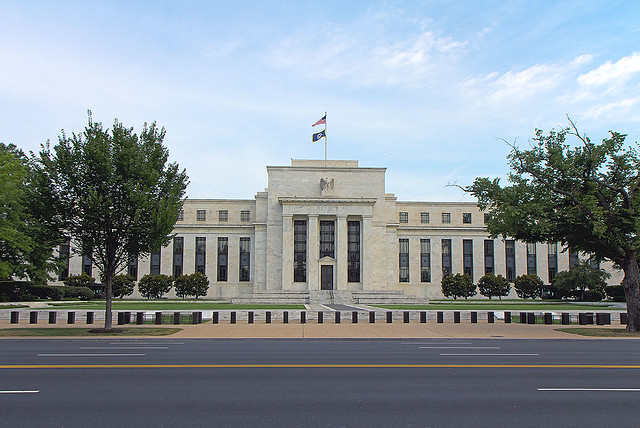During the Great Depression, the Federal Reserve feared the onset of excessive inflation and thus decided to respond by constricting the money supply. This action is the monetary policy equivalent of trying to drive up a hill by slamming on the breaks. Since then, the Fed has developed a complex set of tools to do the exact opposite – increase the money supply – in order to fight off recession. Under normal economic conditions, the Fed can achieve their dual mandate of price stability and maximum sustainable employment by buying/selling treasury notes through open-market operations, changing the Federal funds rate, or otherwise influencing interest rates and the money supply. Increasing the supply of money and lowering the interest rates make spending in the present relatively more desirable, in turn stimulating the economy.
However, when short-term interest rates approach the zero mark, the Fed cannot use these tools to stimulate the economy; negative nominal interest rates are undesirable as individuals will simply hold on to paper money. This places a zero lower bound (ZLB) on efforts stimulate the economy by lowering the interest rates. Given that the Fed will be constrained by the ZLB up to 40% of the time in the near future, it is imperative that the Fed develop expansionary tools for when lowering interest rates can no longer work. One possible tool is the use of “lower-for-longer” policies that indirectly lower the long term interest rate and thus incentivize spending. Though far from perfect, lower-for-longer policies should serve as a tool when the Fed is operating near the ZLB. In order to maximize lower-for-longer policies’ effectiveness though, the Fed must clearly state its intention to use such policies before a situation requiring them occurs.
Lower-for-longer policies consist of the Fed promising to keep interest rates lower than traditional calculations would suggest they should after the economy recovers from a recession. By promising to keep interest rates low, the Fed effectively lowers long-term interest rates. Former Fed Chairwoman Janet Yellen explains that lower-for-longer policies can “cause long-term rates to decline when the zero lower bound begins to bind by about as much as would occur in the absence of any effective lower bound at all.” Additionally, former Fed chairman Ben Bernanke notes that lower long-term interest rates provide an expansionary force because “market participants … bid down longer-term yields and bid up asset prices today, effectively adding stimulus despite the ZLB constraint.” Clearly, lower-for-longer policies can effectively stimulate the economy when other tools fail.
However, keeping interest rates low during recovery can result in unintended consequences. On the back end of lower-for-longer policies, critics worry, lower rates would “let the economy overheat and let inflation run rampant.” While it is true that low interest rates can lead to unhinged post-recession inflation expectations in certain situations, this shouldn’t be a major concern for lower-for-longer policies specifically. As long as market participants know that the low interest rates are temporary, an inflation over the target will be understood as an extension of the lower-for-longer policy. Individuals will then expect a long run return to target inflation rates after the promised period of lower rates. Thus, the risk of overheating is minimal, as long-term inflation predictions will be stable, preventing an upwards spiral in price levels. Obviously, this requires individuals to understand that above-target inflation is an extension of the Fed’s policy, highlighting that effective communication of the policy and its potential impacts is vital.
Clear communication about lower-for-longer policies is necessary not only to mitigate potential back-end overinflation but also to ensure that individuals trust the Fed to actually keep rates lower. Though Bernanke explains that “central bankers’ concerns for their own reputations and those of their institutions, as well as the tendency of market participants to look for focal points around which expectations can coalesce, appear in practice to provide monetary policymakers some ability to commit to future policy actions,” there is still reason to believe the public won’t trust the Fed’s promises. The Fed’s dual mandate requires them to strive for price stability (and thus keep inflation under control), so there exists an incentive for the Federal Open Market Committee (the policymaking instrument of the Fed) to renege on the promise to keep rates low, especially if the economy appears to be overheating. If individuals don’t believe that the Fed will actually follow through on its promise, the perceptual reduction of long-term interest rates (and thus the stimulus) will fail to materialize.
Clearly explaining a commitment to lower-for-longer policies before their use is required will encourage trust in the Fed’s willingness to follow through with low rates. In the same way that a politician’s promises are more believable if they’ve been held for a long time (that’s why voters are skeptical when politicians shift positions), the Fed’s promise to hold rates low would be significantly more credible if it was established before the Fed found itself in a position where lower-for-longer policies were the only possible solution. Additionally, a clear explanation of lower-for-longer policies allows people to understand them better than they would if they were just sprung on the public. This is why Chairwoman Yellen proposes a “a credible statement endorsing such an approach, ideally before the next economic downturn.”
Unfortunately for the Fed, the clock is ticking. Economists at UBS, a Swiss investment bank, predict a 73% chance of recession in 2019. Whether or not a recession actually occurs, the earlier the Fed takes a stance on lower-for-longer policies, the better. Lower-for-longer policies have the potential to be an incredibly effective expansionary tool for the Fed when constricted by the ZLB, and potential side effects are largely mitigated by a clear statement of support. The Fed has developed many tools since it bungled the Great Depression, and lower-for-longer policies need to be added to this list of strategies.
Photo: “The Federal Reserve“
